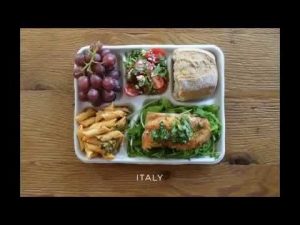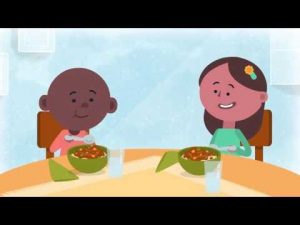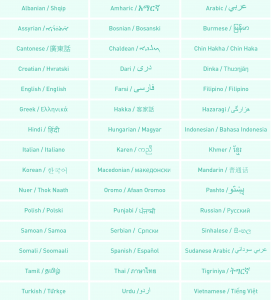18 School lunches
Anita Accendere
School Lunches
The following resources should assist parents to prepare culturally appetising school lunches:

This video presentation links to ethnic lunch ideas from culturally diverse backgrounds.

The video, “Let’s Eat Dinner” (Everyday Learning, 2019b), is a great way to teach preschool children to respect, appreciate and positively interact with people who are different from themselves (Child Australia, 2017). The video models inclusive behavior so children learn the appropriate way of being and doing, it is also an interesting video that displays positive differences between culturally diverse children who eat different types of foods that reflect their cultural identity (Child Australia, 2017; Everyday Learning, 2019a). To support French families within the centre better understand what foods can be included in healthy school lunches, this video has been translated into French (Everyday Learning, 2019a).
LINK: https://www.pbslearningmedia.org/resource/ket-earlychild-ss10/lets-eat-dinner/ (Early Learning, 2019b).
What is Language Loop?
Language Loop is a free interpreting and translating service for government schools and early childhood settings to communicate with families regarding certain activities (Victoria State Government, Education & Training, 2019a). Language Loop can translate school or early childhood services notices such as “Making the first day a success” (Department of Education Training & Employment, [DETE], n.d.; Victoria State Government, Education & Training, 2019a). This notice simplifies what guidelines parents should adhere to when packing their child’s lunch (DETE, n.d.). The guideline suggests healthy food and drinks in realistic portions (DETE, n.d.). Language Loop has translators and interpreting services that teachers can access in order to translate many early childhood notices (Victoria State Government, Education & Training, 2019a). There is also a list of nineteen multilingual school notices that can be translated for parents in their first spoken language by organising a teacher-parent interview (Victoria State Government, Education & Training, 2019a). For example, one of the languages that can be translated is Hindi (Victoria State Government, Education & Training, 2019b). Therefore, Language Loop is a great resource that educators can use to support understanding regarding healthy school lunches (among other issues) between the early childhood service and the diverse families within their centre.

Rationale
The above Digital Resource was created in response to the educators’ concern asking for guidelines to help parents from culturally diverse backgrounds prepare school lunches. The educators are very aware that Australia continues to become more culturally diverse (Gunn, Bennett & Morton, 2013). This is evident when one educator within the Early Learning Centre stated, “Rice is suitable for school lunches and I am aware one of the main meals from your ethnic culture is rice, it does not have to be sandwiches”. Therefore, the resource was made as educators wish to embrace a culturally responsive pedagogy due to many children and their families coming from culturally diverse backgrounds (Gay, 2002; Gunn, Bennett & Morton, 2013; Ladson-Billings, 1995).
While packed school lunches are commonplace in Australia, research suggests that the concept of packed lunches is rather strange for families whose cultural background has not had experience with ‘packed school lunches’ (Child Australia, 2017). One way to communicate with parents from culturally diverse backgrounds is to present a video that highlights healthy school lunches from around the world, in visual images (Food Around the World, 2015).
Schools and early learning centres have an important role in promoting healthy eating and physical activity to ensure all children are provided within learning environments that supports healthy lifestyles (Education Queensland, 2019). This aligns with the National Quality Standard [NQS], where the aim of Quality Standard 2 is to safeguard and promote children’s health and safety (Australian Children’s Education & Care Quality Authority [ACECQA], 2020a). The NQS also promotes culturally respectful pedagogy.
The three resources above not only assist parents in packing culturally appropriate school lunches, but also meet children’s diverse needs by highlighting cultural acceptance and showing value for who they are (Early Learning, 2019a; Early Learning, 2019b; Child Australia, 2017; Early Childhood Resource Hub, [ERCH], n.d.). The videos help children recognise and respect diversity (skin colour, clothing, food, language and so forth), which supports young children to challenge discrimination and bias by understanding the value of cultural diversity (Everyday Learning, 2019a; Everyday Learning, 2019b; Child Australia, 2017; Early Childhood Resource Hub, [ECRH], n.d.).
Research suggests that children as young as three years of age can show bias behaviour and attitudes, so educating very young children about respect for multiculturalism will reduce prejudicial behaviors and attitudes (Child Australia, 2017). Therefore, all children must be treated fairly and equitably within any early childhood setting (ECRH, n.d.).
When the three resources are shared with parents and children, reflecting their own social and cultural backgrounds, feelings of confidence that their culture is reflected in the service is ensured (ERCH, n.d.). This means the service makes all parents feel valued, allows parents to participate in the service and assures them that their child is valued and included in all learning and teaching experiences, despite of any multicultural differences (ERCH, n.d.).
Multimodal Pedagogies in Diverse Classrooms
The above resource can be described as a multimodal approach to representation and communication with families from various culturally and linguistically diverse backgrounds (Kress & Van Leeuwen, 2005, as cited in Stein, 2008, p. 2). Using a multimodal approach to teaching and learning in classrooms addresses any language barrier as it is supported by images, gesture, colour, sound and movement (Stein, 2008). All of which is a positive and interactive way to communicate meaning to the parents regarding different types of culturally diverse ethnic foods students may bring for their school lunches (Stein, 2008). The multimodal presentations outlined in the digital resource above use oral presentations in English and in other languages. However, because the pictures illustrate, in visual form, ideas for healthy choices regarding school lunches, parents can more easily understand what is expected of them when packing their child’s school lunch (Food Around the World, 2015). This is an example that the teacher works in partnership with children and their families to build positive relationships within their local communities (Australian Human Rights Commission, 2016).
Links to the Early Years Learning Framework, [EYLF] (Department of Education, Employment & Workplace Relations, [DEEWR] , 2009):
OUTCOME 1: Children have a strong sense of identity.
– Children feel safe, secured and supported
– Children develop knowledgeable and confident identities
– Children learn to interact in relation to others with respect
OUTCOME 2: Children are connected with and contribute to their world
– Children respond to diversity with respect
– Children become aware of fairness
OUTOME 3: Children have a strong sense of wellbeing.
– Children become strong in their social and emotional wellbeing
OUTCOME 5: Children are confident and involved learners.
– Children engage with a range of texts and gain meaning from these texts
– Children express ideas and make meaning using a range of media
Links to the National Quality Standard, [NQS]-Quality Area 6
• Teachers can recognise that collaborative relationships with families play a critical role in order to achieve quality outcomes for children (ACECQA, 2020e)
• Teachers must build supportive relationships with families to create and enhance respectful relationships with families that are developed and maintained, and families are supported in their parenting role when choosing ethnic school lunches for their child that reflects their cultural backgrounds (ACECQA, 2020e).
• Collaborative relationships between teachers and parents enhance children’s inclusion, learning and overall wellbeing (ACECQA, 2020e).

